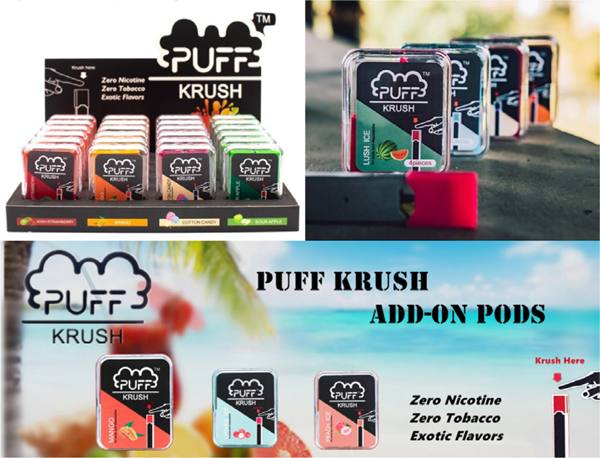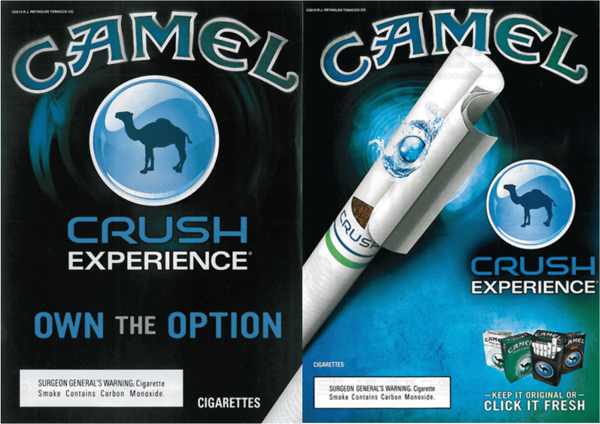JUUL labs transformed the electronic cigarette (e-cigarette) market when they introduced their innovative nicotine salt e-cigarette device in 2015.1 The sleek pod device quickly became the most commonly used tobacco product among adolescents.2 Like other products, JUUL was initially available in mango, mint and a variety of other flavours appealing to youth.3 However, due to rising pressure from the US Food and Drug Administration (FDA) and antitobacco groups, JUUL voluntarily stopped selling all flavoured pods except for menthol, mint, and tobacco in October 2019. Subsequently, after findings from a national study reported that mint flavour was the most popular JUUL flavour used among youth,3 JUUL also removed their mint flavour from the market in November 2019, leaving only menthol and tobacco flavoured pods. With millions of JUUL users—many of them youth—reporting that the variety of flavours offered was one of the most appealing aspects of the product,1 manufacturers of similar pod-style devices resembling JUUL have since tried to capitalise on this market void.4 A recent addition to the pod device family of products may now allow JUUL users to once again consume flavoured highly addictive nicotine salts: PUFF Krush.
PUFF Krush are flavour-filled silicone pod attachments that are compatible with JUUL and other similarly shaped devices, and can be purchased online and at vape shops. The flavour pod attachments simply snap onto the device mouthpiece and resemble the shape and colours of JUUL pods (figure 1). PUFF Krush add-ons are advertised as ‘flavour enhancers’, allowing the user to modify the flavour profile of their preferred nicotine salts device; available flavours include fruit flavours, such as mango and sour apple, and ‘ice’ flavours such as peach ice.5 Thus, JUUL users can use PUFF Krush with their JUUL device to effectively add multiple flavours to otherwise now-unflavoured JUUL pods, or to circumvent policies that prohibit the sale of flavoured nicotine products.6 While these attachments do not contain nicotine themselves, thus may not be considered tobacco products per se, their sole intention is to be used with a tobacco product. As such, these products could be considered e-cigarette device ‘components’ subject to regulation as tobacco products by the FDA.
Figure 1.
Example images of PUFF Krush flavour pod attachments.
PUFF Krush attachments seem reminiscent of Camel Crush cigarettes, which feature a similar interactive ‘crushing’ experience for the consumer and allow modification of the product’s flavour profile (figure 2).7 Focus group data from young adult menthol cigarette smokers showed that the ‘crushing’ aspect of Camel Crush cigarettes was fun, entertaining, something new to experiment with when bored, provided more options and appealed to kids rather than adult established smokers.8 While these two products share similar features, they also differ in important ways. The Camel Crush flavour capsule is embedded within the product itself, while PUFF Krush attachments are sold separately and are compatible with a wide variety of products. Moreover, PUFF Krush attachments allow dozens of flavour combinations.
Figure 2.
Example of Camel Crush cigarette advertisement.
While this report focused on PUFF Krush, it should be noted that similar flavour pod attachment products may exist or soon come to market. Moving forward, tobacco researchers should consider assessment of flavour pod attachments in surveys to monitor prevalence estimates of these new products. Additional data on market availability, including where such products are purchased, what flavours are available, cost of these products, use of the products to circumvent other regulatory policies (eg, flavoured tobacco product prohibitions), and sale to and use by those under the legal age for sale of tobacco products are needed to inform regulatory efforts. Future research should also investigate whether flavour pod attachments introduce greater risk for e-cigarette use experimentation, sustained e-cigarette use, or the development of nicotine dependence, particularly among youth and young adults.
Acknowledgments
Funding Research reported in this publication was supported by grant number U54CA180905 and R01CA229617 from the National Cancer Institute at the National Institutes of Health (NIH) and the Food and Drug Administration Center for Tobacco Products, grant number K01DA042950 from the National Institute for Drug Abuse at NIH, and grant 27-IR-0034 from the Tobacco Related Disease Research Program.
Footnotes
Twitter Sam N Cwalina @SamCwalina
Competing interests None declared.
Patient consent for publication Not required.
Provenance and peer review Not commissioned; externally peer reviewed.
Data availability statement There are no data in this work.
REFERENCES
- 1.The Truth Initiative Behind the explosive growth of JUUL: social influences and flavors? drive rising teen use of the top e-cigarette. Washington, DC, 2018. [Google Scholar]
- 2.Cullen KA, Gentzke AS, Sawdey MD, et al. E-Cigarette use among youth in the United States, 2019. JAMA 2019;322:2095. [DOI] [PMC free article] [PubMed] [Google Scholar]
- 3.Leventhal AM, Miech R, Barrington-Trimis J, et al. Flavors of e-cigarettes used by youths in the United States. JAMA 2019;322:2132. [DOI] [PMC free article] [PubMed] [Google Scholar]
- 4.Williams R. The rise of disposable JUUL-type e-cigarette devices. Tob Control 2019:tobaccocontrol-2019–055379. [DOI] [PMC free article] [PubMed] [Google Scholar]
- 5.PuffSalt. com. Puff Krush. Available: https://www.puffsalt.com/collections/puff-krush [Accessed 20 Feb 2020].
- 6.YouTube. com. Puff krush. Available: https://www.youtube.com/results?search_query=puff+krush [Accessed 20 Feb 2020].
- 7.Trinkets & Trash. Camel crush experience. own the option. Rutgers school of public health, 2013. Available: www.trinketsandtrash.org/detail.php?artifactid=7698&page=2
- 8.Wackowski OA, Evans KR, Harrell MB, et al. In their own words: young adults’ menthol cigarette initiation, perceptions, experiences and regulation perspectives. Nicotine Tob Res 2018;20:1076–84. [DOI] [PMC free article] [PubMed] [Google Scholar]




